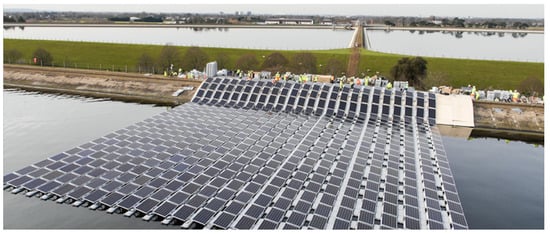Your browser does not fully support modern features. Please upgrade for a smoother experience.
Please note this is a comparison between Version 1 by Aritra Ghosh and Version 3 by Catherine Yang.
Floating photovoltaics (FPV) addresses this issue by installing solar photovoltaics (PV) on bodies of water. Globally, installed FPV is increasing and becoming a viable option for many countries.
- floating photovoltaics (FPV)
- floating solar
- floatovoltaics
- Water
- Low-cost
- Ecosystem
1. Introduction
As the world population continues to grow, the energy demand is also increasing, causing an increase in use of fossil fuels, which emit greenhouse gases [1]. As climate change continues to worsen, the world is looking at ways to reduce greenhouse gas emissions [2][3][2,3]. The world is facing a climate crisis. The International Energy Agency (IEA) reported that in order for the world to reach the goal of net zero emissions by 2050 there will have to be an annual average solar energy generation growth of 24% [4]. In 2020, solar generation increased 23%, resulting in the IEA categorising solar photovoltaics (PV) as ’more effort needed’ [4].
Solar PV is expected to be a leading technology to power the world in the future [5]. The price of PV has reduced drastically, reaching a price similar to that of conventional energy sources [6][7][6,7]. The IEA stated that PV has become the lowest-cost electricity source in history [4]. While installed PV is set to continue growing, the large scale ground-mounted photovoltaic (GPV) farms are running into issues of finding land to install on [8]. A 1MW PV farm needs approximately 15,000 m2 of land [9]. With large land requirements and rising land prices it is becoming increasingly difficult to purchase land for a PV farm [10]. Other challenges faced by PV installations are cooling of the panels and keeping them free of dust in order to increase energy efficiency [11]. A solution to this challenge is placing PV on bodies of water such as ponds, lakes, reservoirs, oceans, canals, lagoons, waste water treatment plants, or irrigation ponds [12]. The placing of PV panels on top of bodies of water is called floating photovoltaics (FPV) or floatovoltaics. Countries that are facing challenges with land availability for PV farms are looking towards the potential of FPV [13].
23. Technology
A general FPV system consists of PV panels and system installed atop a floating structure that is anchored to the ground as seen in Figure 14.
2.1. Floating Structure
A pontoon structure is used to keep the system floating in the water [12]. The pontoons are formed by attaching floats together in order to hold the weight of the structure on top of the water [12][14][12,18]. The majority of floats used in the industry are made out of high-density polyethylene (HDPE) due to it being UV resistant, corrosion resistant, maintenance free, recyclable and having good tensile strength [12]. Another material used for floats, though less common, is glass fibre reinforced plastic [12]. These systems generally have a set panel inclination that is not easily adjusted once installed [14][18]. A benefit of the floating structures is that they are easy to decommission compared to a GPV system [15][19]. Other floating structure options include galvanized steel platforms and one or two axis tracking platforms [14][18].2.2. PV Module
The commonly used module type for FPV installations is crystalline silicon [12]. Crystalline modules work well in fresh water environments, but as the sector looks toward marine environments, modules will need to be designed to withstand the salty environment. Therefore, standard metal frames will need to be replaced with an alternative material [12]. There is potential to also use second generation CdTe [16][17][18][20,21,22], a-Si, or CIGS [19][23], but there has been limited investigation with these technologies. Third-generation PV is not considered yet for FPV due to the lack of maturity [20][21][22][23][24,25,26,27].2.3. Mooring
The mooring system of an FPV installation is required to hold the system in place, avoiding overturning or floating away [12]. The system can be moored with anchors on the ground of the body of water, or alternatively, directly to shore [14][18]. Nylon ropes are often used as the mooring lines and allow movement of the system for changes in water depth and blowing wind [24][28].2.4. Cables
Underwater cables can be used to transport the generated electricity to an onshore substation [14][18]. It is also common to keep the cables above the water [12].2.5. Installation
The installation process for FPV is often easier than that for GPV, as long as the anchoring and mooring system is not complicated [25][14]. The installation does not require heavy equipment and the system is usually assembled on land and then transferred onto the body of water where it can be towed to the site [25][26][14,29]. Lightsource, a company in the United Kingdom, used a ramp to roll FPV into the water [27][30]. The installation can be seen in Figure 25.
2.6. Location
In order to choose a suitable FPV location, there is a list of criteria that must be taken into consideration. Table 12 breaks down the key criteria that must be analysed before selecting a location to install FPV.| Feature | Criteria |
|---|---|
| Weather | High irradiance |
| Limited rain or fog | |
| Wind speeds below 30 m/s | |
| Location | No shadowing from mountains or surrounding buildings |
| Convenient transportation | |
| Convenient installation and maintenance | |
| Close to electrical connection | |
| Ground conditions | Consistent terrain |
| Compact soil for anchoring | |
| Water conditions | Limited waves |
| Fresh water | |
| Low hardness | |
| Low salinity |
